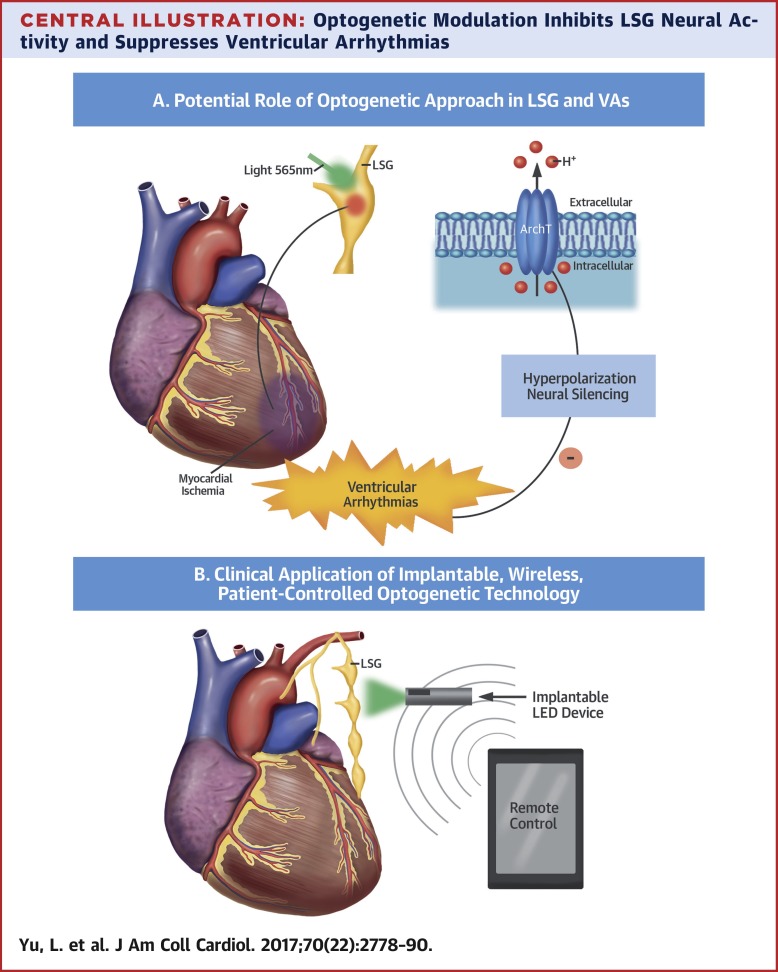当前位置:
X-MOL 学术
›
J. Am. Coll. Cardiol.
›
论文详情
Our official English website, www.x-mol.net, welcomes your feedback! (Note: you will need to create a separate account there.)
Optogenetic Modulation of Cardiac Sympathetic Nerve Activity to Prevent Ventricular Arrhythmias
Journal of the American College of Cardiology ( IF 24.0 ) Pub Date : 2017-12-01 , DOI: 10.1016/j.jacc.2017.09.1107 Lilei Yu , Liping Zhou , Gang Cao , Sunny S. Po , Bing Huang , Xiaoya Zhou , Menglong Wang , Shenxu Yuan , Zhuo Wang , Songyun Wang , Hong Jiang
Journal of the American College of Cardiology ( IF 24.0 ) Pub Date : 2017-12-01 , DOI: 10.1016/j.jacc.2017.09.1107 Lilei Yu , Liping Zhou , Gang Cao , Sunny S. Po , Bing Huang , Xiaoya Zhou , Menglong Wang , Shenxu Yuan , Zhuo Wang , Songyun Wang , Hong Jiang

|
BACKGROUND
Studies have shown that left stellate ganglion (LSG) suppression protects against ventricular arrhythmias (VAs). Optogenetics is a novel technique to reversibly regulate the activity of the targeted neurons. OBJECTIVES
This study aimed to investigate whether an optogenetically silenced LSG could protect against VAs induced by myocardial ischemia. METHODS
Adeno-associated virus (AAV) was used as the vector to deliver ArchT, an inhibitory light-sensitive opsin, to the LSG neurons. Twenty male beagles were randomized into the optogenetics group (n = 10, AAV2/9-CAG-ArchT-GFP microinjected into LSG) and control group (n = 10, AAV2/9-CAG-GFP microinjected into LSG). After 4 weeks, the LSG function and neural activity, heart rate variability, ventricular action potential duration, and effective refractory period were measured in the absence or presence of a light-emitting diode illumination (565 nm). Myocardial ischemia was induced by left anterior coronary artery ligation and 1 h of electrocardiography was recorded for VAs analysis. RESULTS
ArchT was successfully expressed in all dogs. Transient light-emitting diode illumination significantly suppressed the LSG function, LSG neural activity, and sympathetic nerve indices of heart rate variability as well as prolonged left ventricular effective refractory period and APD90 only in the optogenetics group. Thirty-minute illumination further enhanced these changes in the optogenetics group. Importantly, all of these changes returned to baseline within 2 h after illumination was turned off. Moreover, the ischemia-induced VAs were significantly suppressed by illumination only in the optogenetics group. CONCLUSIONS
Optogenetic modulation could reversibly inhibit the neural activity of LSG, thereby increasing electrophysiological stability and protecting against myocardial ischemia-induced VAs.
中文翻译:

心脏交感神经活动的光遗传学调节以预防室性心律失常
背景研究表明,左星状神经节 (LSG) 抑制可预防室性心律失常 (VA)。光遗传学是一种可逆地调节目标神经元活动的新技术。目的 本研究旨在探讨光遗传学沉默的 LSG 是否可以预防心肌缺血引起的 VA。方法使用腺相关病毒(AAV)作为载体将抑制性光敏视蛋白 ArchT 递送至 LSG 神经元。20 只雄性小猎犬被随机分为光遗传学组(n = 10,AAV2/9-CAG-ArchT-GFP 微注射到 LSG)和对照组(n = 10,AAV2/9-CAG-GFP 微注射到 LSG)。4 周后,LSG 功能和神经活动、心率变异性、心室动作电位持续时间、和有效不应期是在发光二极管照明 (565 nm) 不存在或存在的情况下测量的。左前冠状动脉结扎诱发心肌缺血,记录 1 小时心电图用于 VA 分析。结果 ArchT 在所有犬中均成功表达。仅在光遗传学组中,瞬态发光二极管照明显着抑制了 LSG 功能、LSG 神经活动和心率变异性的交感神经指数以及延长的左心室有效不应期和 APD90。30 分钟的光照进一步增强了光遗传学组的这些变化。重要的是,所有这些变化在照明关闭后 2 小时内恢复到基线。而且,仅在光遗传学组中,缺血诱导的 VA 被光照显着抑制。结论 光遗传学调制可以可逆地抑制 LSG 的神经活动,从而增加电生理稳定性并防止心肌缺血引起的 VAs。
更新日期:2017-12-01
中文翻译:

心脏交感神经活动的光遗传学调节以预防室性心律失常
背景研究表明,左星状神经节 (LSG) 抑制可预防室性心律失常 (VA)。光遗传学是一种可逆地调节目标神经元活动的新技术。目的 本研究旨在探讨光遗传学沉默的 LSG 是否可以预防心肌缺血引起的 VA。方法使用腺相关病毒(AAV)作为载体将抑制性光敏视蛋白 ArchT 递送至 LSG 神经元。20 只雄性小猎犬被随机分为光遗传学组(n = 10,AAV2/9-CAG-ArchT-GFP 微注射到 LSG)和对照组(n = 10,AAV2/9-CAG-GFP 微注射到 LSG)。4 周后,LSG 功能和神经活动、心率变异性、心室动作电位持续时间、和有效不应期是在发光二极管照明 (565 nm) 不存在或存在的情况下测量的。左前冠状动脉结扎诱发心肌缺血,记录 1 小时心电图用于 VA 分析。结果 ArchT 在所有犬中均成功表达。仅在光遗传学组中,瞬态发光二极管照明显着抑制了 LSG 功能、LSG 神经活动和心率变异性的交感神经指数以及延长的左心室有效不应期和 APD90。30 分钟的光照进一步增强了光遗传学组的这些变化。重要的是,所有这些变化在照明关闭后 2 小时内恢复到基线。而且,仅在光遗传学组中,缺血诱导的 VA 被光照显着抑制。结论 光遗传学调制可以可逆地抑制 LSG 的神经活动,从而增加电生理稳定性并防止心肌缺血引起的 VAs。


























 京公网安备 11010802027423号
京公网安备 11010802027423号